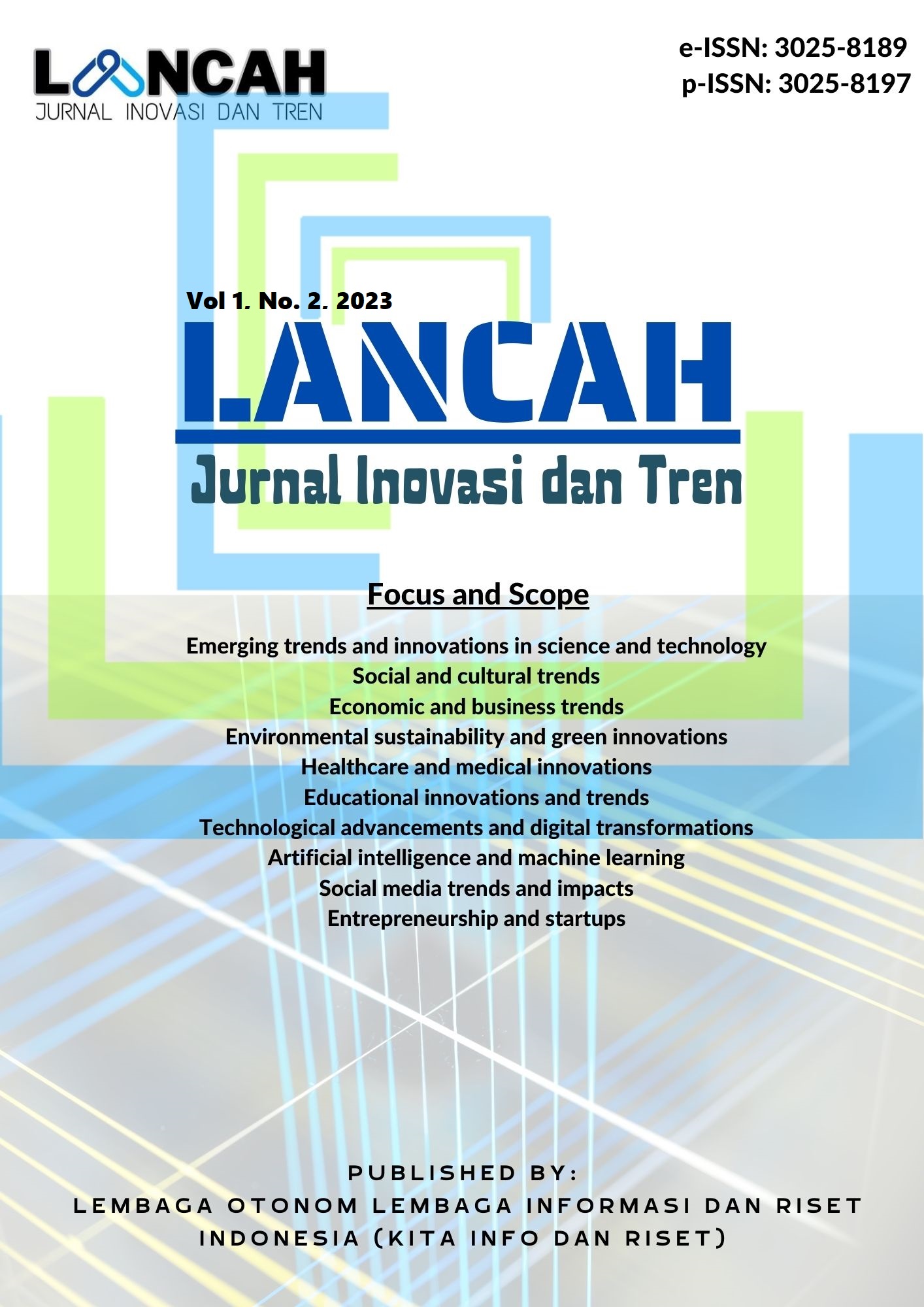Hubungan Antara Penggunaan Media Sosial dan Kecemasan Sosial pada Generasi Milenial
DOI:
https://doi.org/10.35870/ljit.v1i2.2155Keywords:
Social Media Use, Social Anxiety, Millennial Generation, Online Social InteractionAbstract
This study aims to investigate the relationship between social media use and social anxiety in the millennial generation. Using literature research methods and correlation analysis, we collected data from respondents representing this generation to explore the impact of the intensity of social media use on levels of social anxiety. The research results show that there is a significant negative relationship between social media use and social anxiety in the millennial generation. These findings provide further understanding of how social media can act as an alternative channel in reducing levels of social anxiety among this generation. However, it should be noted that this influence may be influenced by various contextual and psychological factors. The implications of this research include the potential to develop intervention strategies that support the mental well-being of the millennial generation through managing social media use. These conclusions make a positive contribution to our understanding of the complex dynamics between technology and psychological well-being, opening the door to further research in this area.
Downloads
References
P. Hidayat, “Interaksi sosial online dan kecemasan sosial sebagai prediktor kecanduan internet pada remaja,” Jurnal Ilmiah Psyche, vol. 14, no. 2, pp. 83–92, 2020.
H. A. Zanki, “Teori Psikologi Dan Sosial Pendidikan (Teori Interaksi Simbolik),” Scolae: Journal of Pedagogy, vol. 3, no. 2, 2020.
F. Azka, D. F. Firdaus, and E. Kurniadewi, “Kecemasan sosial dan ketergantungan media sosial pada mahasiswa,” Psympathic: Jurnal Ilmiah Psikologi, vol. 5, no. 2, pp. 201–210, 2018.
S. I. Savira, “Hubungan Halo Effect dengan Kecemasan Sosial Halo Effect Relationship With Social Anxiety,” 2022.
M. B. Stein and D. J. Stein, “Social anxiety disorder,” The lancet, vol. 371, no. 9618, pp. 1115–1125, 2008.
A. A. Unde and S. Azis, “Pengungkapan identitas diri melalui media sosial: Studi mengenai etnografi virtual melalui vlog,” KAREBA: Jurnal Ilmu Komunikasi, pp. 83–92, 2018.
F. H. A. Putro, “Perilaku penggunaan media sosial dan identitas diri (studi deskriptif kualitatif tentang perilaku penggunaan media sosial dan identitas diri di kalangan mahasiswa S1 Jurusan Komunikasi Universitas Slamet Riyadi Surakarta),” 2017.
D. Pratama, T. Widodo, and S. T. Maulia, “Penggunaan Media Digital dan Partisipasi Politik Milenial,” Civilia: Jurnal Kajian Hukum dan Pendidikan Kewarganegaraan, vol. 2, no. 2, pp. 79–89, 2023.
S. F. Soliha, “Tingkat ketergantungan pengguna media sosial dan kecemasan sosial,” Interaksi: Jurnal Ilmu Komunikasi, vol. 4, no. 1, pp. 1–10, 2015.
R. R. Zulkarnain and S. R. Manalu, “PENGARUH TINGKAT FEAR OF MISSING OUT (FOMO) DAN TINGKAT SOCIAL OVERLOAD TERHADAP INTENSI PENGHENTIAN PENGGUNAAN INSTAGRAM,” Interaksi Online, vol. 11, no. 4, pp. 206–221, 2023.
A. Sudrajat, “Apakah Media Sosial Buruk untuk Kesehatan Mental dan Kesejahteraan? Kajian Perspektif Remaja,” Jurnal Tinta: Jurnal Ilmu Keguruan dan Pendidikan, vol. 2, no. 1, pp. 41–52, 2020.
K. Rentzsch, M. Schröder-Abé, and A. Schütz, “Envy mediates the relation between low academic self-esteem and hostile tendencies,” J Res Pers, vol. 58, pp. 143–153, 2015.
Y. Hong, L. Liu, R. Lin, and R. Lian, “The relationship between perceived control and life satisfaction in Chinese undergraduates: the mediating role of envy and moderating role of self-esteem,” Current Psychology, pp. 1–9, 2020.
S. A. Tan, W. M. Tay, M. E. Y. Neoh, and H. W. Wong, “The association between perceived discrimination and suicide among homosexuals: The role of self-esteem as mediator,” Makara Human Behavior Studies in Asia, vol. 22, no. 1, pp. 22–28, 2018.
Sufriadi, D., Agustina, Y., Zakaria, Z. and Hamid, A., 2022. Kesiapan Mahasiswa Mengaplikasikan Pembelajaran Berbasis Daring. Jurnal Ilmiah Profesi Pendidikan, 7(4b), pp.2492-2500.
Sufriadi, D. and Zakaria, Z., 2021. Efektivitas Pembelajaran Daring di Masa Pandemi COVID 19 Bagi Mahasiswa Universitas Serambi Mekkah Banda Aceh. Innovative: Journal of Social Science Research, 1(2), pp.609-613.
Downloads
Published
Issue
Section
License
Copyright (c) 2023 LANCAH: Jurnal Inovasi dan Tren

This work is licensed under a Creative Commons Attribution-NonCommercial-ShareAlike 4.0 International License.
Copyright and Licensing Agreement
Authors who publish with this journal agree to the following terms:
1. Copyright Retention and Open Access License
- Authors retain full copyright of their work
- Authors grant the journal right of first publication under the Creative Commons Attribution 4.0 International License (CC BY 4.0)
- This license allows unrestricted use, distribution, and reproduction in any medium, provided the original work is properly cited
2. Rights Granted Under CC BY 4.0
Under this license, readers are free to:
- Share — copy and redistribute the material in any medium or format
- Adapt — remix, transform, and build upon the material for any purpose, including commercial use
- No additional restrictions — the licensor cannot revoke these freedoms as long as license terms are followed
3. Attribution Requirements
All uses must include:
- Proper citation of the original work
- Link to the Creative Commons license
- Indication if changes were made to the original work
- No suggestion that the licensor endorses the user or their use
4. Additional Distribution Rights
Authors may:
- Deposit the published version in institutional repositories
- Share through academic social networks
- Include in books, monographs, or other publications
- Post on personal or institutional websites
Requirement: All additional distributions must maintain the CC BY 4.0 license and proper attribution.
5. Self-Archiving and Pre-Print Sharing
Authors are encouraged to:
- Share pre-prints and post-prints online
- Deposit in subject-specific repositories (e.g., arXiv, bioRxiv)
- Engage in scholarly communication throughout the publication process
6. Open Access Commitment
This journal provides immediate open access to all content, supporting the global exchange of knowledge without financial, legal, or technical barriers.











